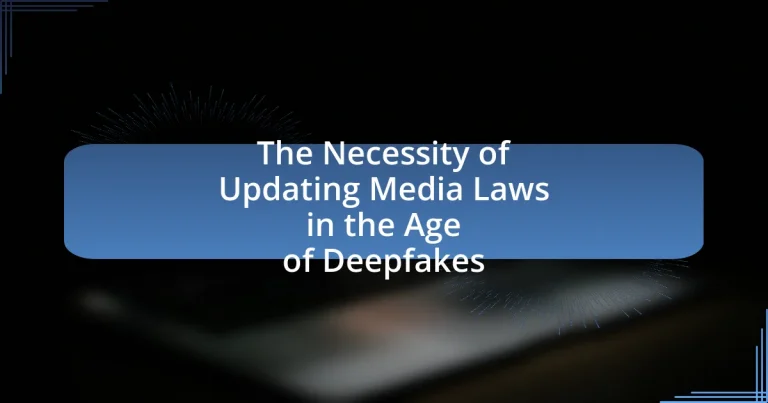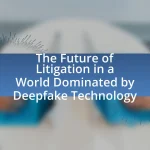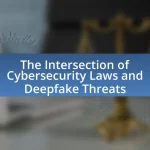The article focuses on the urgent need to update media laws in response to the rise of deepfake technology, which utilizes artificial intelligence to create realistic but manipulated media. It outlines the mechanisms behind deepfakes, including the use of generative adversarial networks, and discusses the potential harms they pose, such as misinformation, erosion of trust in media, and threats to personal privacy. The article highlights the inadequacies of current media laws in addressing these challenges and emphasizes the necessity for new legal frameworks that can effectively regulate the creation and distribution of deepfakes, ensuring accountability and protecting individuals from misuse. Additionally, it explores global perspectives on media law updates and the role of technology companies in shaping these regulations.

What are Deepfakes and Why are They a Concern?
Deepfakes are synthetic media created using artificial intelligence techniques, particularly deep learning, to manipulate or generate realistic images, audio, or video of individuals. They are a concern because they can be used to spread misinformation, damage reputations, and undermine trust in media, as evidenced by incidents where deepfakes have been employed in political campaigns and social media to create false narratives. The potential for deepfakes to facilitate fraud, harassment, and the erosion of privacy further highlights the urgent need for updated media laws to address these emerging threats.
How do Deepfakes work and what technologies are involved?
Deepfakes work by using artificial intelligence, specifically deep learning techniques, to create realistic-looking fake media. The primary technology involved is Generative Adversarial Networks (GANs), which consist of two neural networks: a generator that creates fake images or videos and a discriminator that evaluates their authenticity. The generator improves its output based on feedback from the discriminator, leading to increasingly convincing deepfakes. Additionally, techniques such as autoencoders and facial recognition algorithms are often employed to enhance the quality and accuracy of the generated content. The effectiveness of deepfakes has been demonstrated in various studies, highlighting their potential for misuse in misinformation and identity theft.
What are the key components of Deepfake technology?
The key components of Deepfake technology are machine learning algorithms, particularly generative adversarial networks (GANs), and large datasets of images and videos. Machine learning algorithms enable the creation of realistic synthetic media by learning patterns from existing data. GANs consist of two neural networks, a generator and a discriminator, that work together to produce high-quality fake content. Large datasets provide the necessary training material for these algorithms, allowing them to accurately mimic facial expressions, voice, and movements. This combination of advanced algorithms and extensive data is what makes Deepfake technology capable of producing convincing alterations in media.
How do these technologies create realistic fake media?
Technologies such as deep learning algorithms and generative adversarial networks (GANs) create realistic fake media by analyzing and synthesizing vast amounts of data to produce highly convincing images, videos, and audio. Deep learning models, particularly GANs, consist of two neural networks that compete against each other; one generates fake content while the other evaluates its authenticity, leading to increasingly realistic outputs. For instance, GANs have been used to create hyper-realistic images of people who do not exist, as demonstrated by the “This Person Does Not Exist” website, which showcases the capabilities of these technologies in generating lifelike human faces.
What are the potential harms of Deepfakes in media?
Deepfakes in media pose significant harms, including the spread of misinformation, erosion of trust in authentic content, and potential for defamation. Misinformation can lead to public confusion and manipulation, as deepfakes can convincingly depict individuals saying or doing things they never did, impacting political discourse and public opinion. The erosion of trust occurs as audiences become skeptical of all media, making it difficult to discern truth from fabrication; a study by the Pew Research Center found that 86% of Americans believe misinformation is a major problem. Additionally, deepfakes can facilitate defamation, as individuals may suffer reputational damage from fabricated content, leading to legal and personal consequences.
How can Deepfakes impact public trust in media?
Deepfakes can significantly undermine public trust in media by creating realistic but fabricated content that misleads audiences. The proliferation of deepfake technology has led to instances where manipulated videos and audio are used to spread misinformation, causing viewers to question the authenticity of legitimate media sources. For example, a study by the University of California, Berkeley, found that 85% of participants expressed concern about the potential for deepfakes to distort reality, indicating a growing skepticism towards media content. This erosion of trust can have serious implications for democratic processes and public discourse, as individuals may become more susceptible to believing false narratives presented as credible news.
What are the implications for personal privacy and security?
The implications for personal privacy and security in the age of deepfakes are significant, as the technology can be used to create realistic but false representations of individuals, leading to potential identity theft, defamation, and unauthorized surveillance. Deepfakes can manipulate video and audio content, making it difficult for individuals to protect their likeness and voice from misuse. For instance, a study by the University of California, Berkeley, found that deepfake technology can produce highly convincing fake videos that can mislead viewers, posing risks to personal reputations and safety. Additionally, the proliferation of deepfakes can erode trust in media, making it challenging for individuals to discern authentic content from fabricated material, thereby compromising both personal privacy and broader societal security.
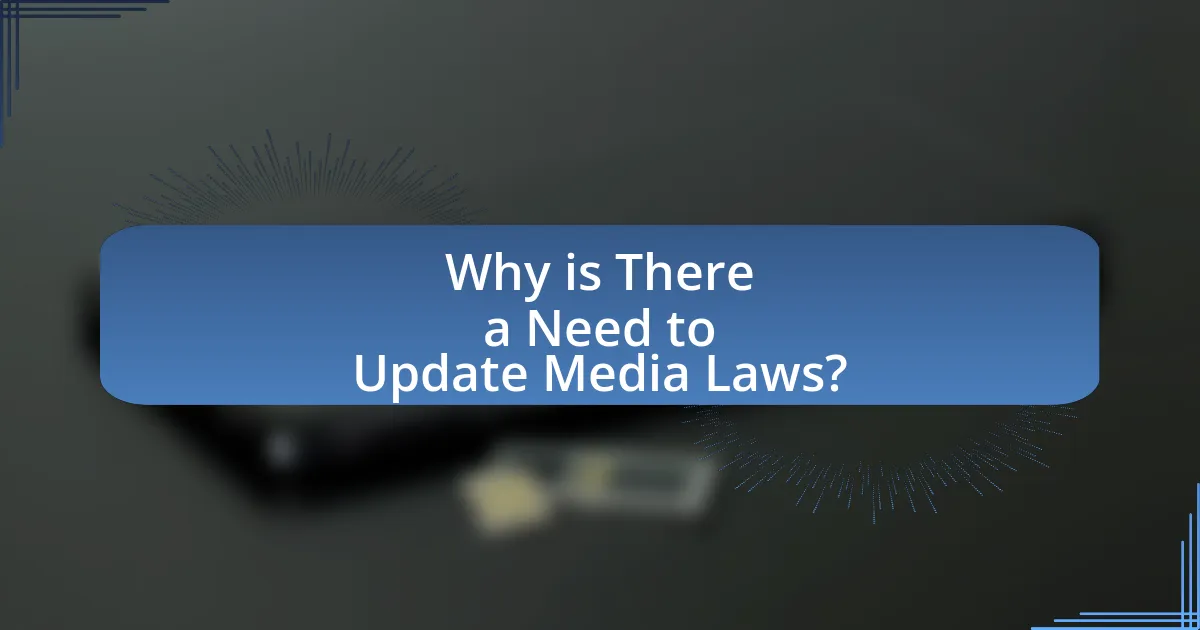
Why is There a Need to Update Media Laws?
There is a need to update media laws to address the challenges posed by technological advancements, particularly deepfakes. As deepfake technology becomes more sophisticated, it raises significant concerns regarding misinformation, defamation, and privacy violations. Current media laws often lack the necessary provisions to effectively regulate the creation and distribution of manipulated content, which can lead to harmful consequences for individuals and society. For instance, a study by the Brookings Institution highlights that deepfakes can undermine trust in media and democratic processes, necessitating legal frameworks that can adapt to these emerging threats.
What current media laws are inadequate in addressing Deepfakes?
Current media laws are inadequate in addressing deepfakes primarily due to their reliance on outdated definitions of fraud and misinformation. Existing laws, such as the Communications Decency Act and various state-level anti-defamation statutes, do not specifically target the unique characteristics of deepfakes, which can blur the lines between reality and fabrication. For instance, the lack of explicit legal frameworks to classify deepfakes as a distinct category of harmful content allows for significant gaps in accountability and enforcement. Additionally, laws governing copyright and intellectual property do not adequately address the unauthorized use of individuals’ likenesses in deepfake technology, leaving victims without clear legal recourse. This inadequacy is evidenced by the increasing prevalence of deepfake incidents in political and social contexts, highlighting the urgent need for updated legislation that specifically addresses the complexities of this technology.
How do existing laws fail to protect individuals from Deepfake misuse?
Existing laws fail to protect individuals from Deepfake misuse primarily due to their inability to address the unique characteristics of this technology. Current legal frameworks often rely on traditional definitions of defamation, fraud, and privacy violations, which do not adequately encompass the complexities of Deepfakes, such as the ease of creating and distributing manipulated content without consent. For instance, the lack of specific legislation targeting Deepfake technology means that victims may struggle to find legal recourse, as existing laws may not recognize the harm caused by synthetic media. Additionally, many jurisdictions lack clear guidelines on the accountability of platforms hosting Deepfake content, leaving individuals vulnerable to reputational damage and emotional distress without effective legal protection.
What gaps exist in legislation regarding digital content authenticity?
Legislation regarding digital content authenticity currently lacks comprehensive frameworks to address the challenges posed by deepfakes and manipulated media. Existing laws often do not specify the legal responsibilities of content creators and distributors, leading to ambiguity in accountability for misinformation. For instance, the absence of clear definitions for what constitutes “authentic” content allows for the proliferation of deceptive media without legal repercussions. Furthermore, many jurisdictions have not updated their laws to include digital content, leaving significant gaps in protection against the misuse of technology for creating misleading representations. This inadequacy is evident in the limited enforcement mechanisms available to combat the spread of deepfakes, as highlighted by the increasing number of incidents where manipulated content has influenced public opinion and electoral processes.
How can updated media laws better address the challenges posed by Deepfakes?
Updated media laws can better address the challenges posed by Deepfakes by implementing stricter regulations on the creation and distribution of manipulated media. These laws can establish clear definitions of Deepfakes, outline penalties for malicious use, and require platforms to develop detection technologies. For instance, the California Assembly Bill 730, enacted in 2019, specifically targets Deepfakes used for malicious purposes, demonstrating a legislative approach to mitigate risks associated with deceptive content. By enforcing accountability and promoting transparency, updated media laws can significantly reduce the potential for misinformation and harm caused by Deepfakes.
What specific legal frameworks could be implemented to combat Deepfakes?
Specific legal frameworks that could be implemented to combat Deepfakes include the establishment of laws that criminalize the malicious creation and distribution of Deepfake content, as well as regulations that require clear labeling of synthetic media. These frameworks can be modeled after existing laws against fraud and defamation, which provide a basis for holding individuals accountable for harm caused by deceptive media. For instance, California’s AB 730 law, enacted in 2019, makes it illegal to use Deepfake technology to harm or defraud others, demonstrating a legislative approach that can be expanded nationally. Additionally, the implementation of copyright protections for original content creators can deter unauthorized use of their likenesses in Deepfake productions.
How can laws balance freedom of expression with the need for regulation?
Laws can balance freedom of expression with the need for regulation by establishing clear guidelines that protect individual rights while addressing harmful content. For instance, regulations can define hate speech, misinformation, and defamation, allowing for the restriction of such expressions without infringing on legitimate discourse. Historical examples, such as the First Amendment in the United States, demonstrate that while freedom of speech is protected, limitations exist to prevent harm, as seen in cases like Brandenburg v. Ohio, where the Supreme Court ruled that speech inciting imminent lawless action is not protected. This framework allows for a nuanced approach that respects free expression while ensuring public safety and social responsibility.
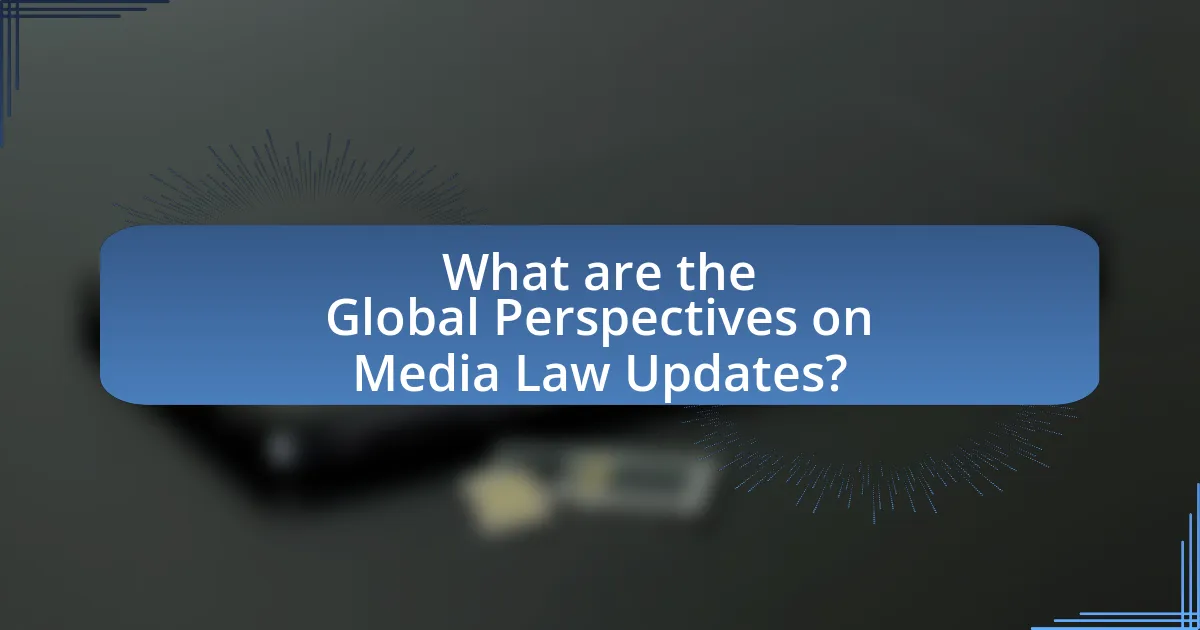
What are the Global Perspectives on Media Law Updates?
Global perspectives on media law updates emphasize the urgent need for legal frameworks to adapt to technological advancements, particularly in the context of deepfakes. Various countries are recognizing the challenges posed by deepfake technology, which can manipulate audio and visual content, leading to misinformation and potential harm. For instance, the European Union has proposed regulations aimed at enhancing transparency and accountability in digital media, while the United States has seen states like California enact laws specifically targeting the malicious use of deepfakes. These updates reflect a growing consensus that existing media laws are insufficient to address the complexities introduced by artificial intelligence and digital manipulation, necessitating a collaborative international approach to establish effective legal standards.
How are different countries approaching the regulation of Deepfakes?
Different countries are approaching the regulation of deepfakes through a combination of legislative measures, public awareness campaigns, and technological solutions. For instance, the United States has seen states like California and Texas enact laws specifically targeting the malicious use of deepfakes, particularly in the context of elections and pornography. In contrast, the European Union is working on comprehensive regulations under the Digital Services Act, which aims to address harmful content, including deepfakes, by imposing stricter accountability on platforms. Additionally, countries like Australia have proposed amendments to existing laws to include deepfake technology, focusing on its potential to deceive and harm individuals. These varied approaches reflect a growing recognition of the need to adapt legal frameworks to the challenges posed by deepfake technology.
What lessons can be learned from international case studies?
International case studies reveal that updating media laws is essential to address the challenges posed by deepfakes. For instance, countries like Germany have implemented strict regulations against the misuse of deepfake technology, demonstrating the need for legal frameworks that protect individuals from misinformation and identity theft. Additionally, the United States has seen various state-level initiatives aimed at criminalizing malicious deepfake creation, highlighting the importance of proactive legal measures. These examples underscore the necessity for comprehensive media laws that adapt to technological advancements, ensuring accountability and safeguarding public trust in media.
How do cultural attitudes towards media influence legal responses?
Cultural attitudes towards media significantly influence legal responses by shaping public perception and legislative priorities. For instance, in societies that prioritize freedom of expression, laws may be more lenient regarding media content, while cultures that emphasize protection from misinformation may advocate for stricter regulations. This is evident in the varying legal frameworks across countries; for example, the United States has robust protections for media under the First Amendment, whereas countries like Germany impose stricter controls to combat hate speech and misinformation. Such cultural perspectives directly impact how laws are formulated and enforced, particularly in the context of emerging technologies like deepfakes, where societal concerns about authenticity and trust in media drive the urgency for legal updates.
What role do technology companies play in shaping media laws?
Technology companies significantly influence the development of media laws by advocating for regulations that align with their business models and technological advancements. These companies often engage in lobbying efforts to shape legislation, such as promoting policies that address issues like copyright, data privacy, and misinformation. For instance, major tech firms have pushed for clearer guidelines on the use of artificial intelligence in media, particularly in response to the challenges posed by deepfakes. This influence is evident in legislative discussions, where technology companies provide expertise and resources that help lawmakers understand the implications of emerging technologies on media practices.
How can collaboration between governments and tech firms enhance regulation?
Collaboration between governments and tech firms can enhance regulation by creating frameworks that address emerging technologies like deepfakes. This partnership allows for the sharing of expertise, where governments can leverage the technical knowledge of tech firms to develop effective regulatory measures. For instance, the European Union’s Digital Services Act exemplifies how regulatory bodies can work with technology companies to establish standards for content moderation and misinformation, ensuring that regulations are both practical and enforceable. Such collaborations can lead to more adaptive and responsive regulations that keep pace with rapid technological advancements, ultimately fostering a safer digital environment.
What responsibilities do platforms have in managing Deepfake content?
Platforms have the responsibility to monitor, identify, and remove Deepfake content that violates their policies or legal standards. This includes implementing advanced detection technologies to recognize manipulated media and ensuring transparency in their content moderation processes. For instance, platforms like Facebook and YouTube have established guidelines that prohibit deceptive content, and they actively collaborate with researchers to improve detection methods. Additionally, they must provide users with clear reporting mechanisms for Deepfake content, thereby fostering accountability and user safety.
What practical steps can be taken to advocate for updated media laws?
To advocate for updated media laws, individuals and organizations can engage in a multi-faceted approach that includes raising public awareness, lobbying policymakers, and collaborating with legal experts. Raising public awareness can be achieved through campaigns that highlight the risks associated with deepfakes, such as misinformation and privacy violations, thereby mobilizing community support for legal reforms. Lobbying policymakers involves directly contacting legislators, participating in public hearings, and presenting evidence-based arguments that demonstrate the need for updated regulations to address the challenges posed by deepfakes. Collaborating with legal experts can provide valuable insights into the complexities of media law and help draft proposals that effectively address these issues. For instance, the rise of deepfake technology has led to increased calls for legislative action, as seen in various states proposing bills to regulate the use of synthetic media.
How can individuals and organizations raise awareness about the need for change?
Individuals and organizations can raise awareness about the need for change by utilizing social media campaigns, educational workshops, and partnerships with advocacy groups. Social media platforms enable rapid dissemination of information, allowing individuals to share articles, videos, and infographics that highlight the implications of outdated media laws in the context of deepfakes. Educational workshops can provide in-depth knowledge and foster discussions about the risks associated with deepfakes, thereby empowering participants to advocate for legal reforms. Collaborating with advocacy groups can amplify voices and create a unified front, increasing visibility and urgency around the issue. For instance, the rise of deepfake technology has been linked to misinformation and potential harm, underscoring the necessity for updated regulations to protect individuals and society.
What strategies can be employed to influence policymakers effectively?
To influence policymakers effectively, stakeholders should employ strategies such as building coalitions, utilizing data-driven advocacy, and engaging in direct communication. Building coalitions allows diverse groups to present a united front, increasing credibility and impact. Data-driven advocacy leverages statistics and research to provide compelling evidence that supports policy changes, as seen in studies demonstrating the effects of misinformation on public trust. Direct communication, including meetings and personalized outreach, fosters relationships and ensures that policymakers understand the urgency and importance of issues like updating media laws in response to deepfakes.
